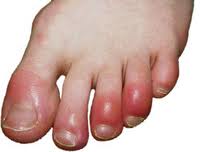What is Chilblains? How to manage it? What are the precautions to be taken? What are the signs and symptoms? What is the cause of this disease? How to treat it? How can homeopathy help you? All of this answered, in this post and of course our doctors always there to help you. Just fill in your details in the form down below and we will answer all your questions for FREE!

What is chilblains?
Painful inflammation of small blood vessels of the skin is called chilblains. Sudden warming up of body from cold temperature results in chilblains.
A chilblain is also known as perniones. It is characterized by itching, red patches, swelling and blistering on toes, fingers, ears and nose.
Commonly chilblains affect the following parts of body: Fingers and toes, legs, heels and ears.
Due to cold exposure or in humid or damp conditions there is abnormal vascular response. Minor trauma may aggravate the condition.
Chilblains are a common occurrence. The abnormal reaction of skin to cold results in chilblains. Chilblains commonly occur on extremities as it easily becomes cold.
When the skin becomes cold the blood vessels under the skin become narrow resulting in slow supply of blood to that area of skin. On warming up of the skin there is some leakage of fluid from blood vessels into the surrounding tissues. This results in inflammation and hence chilblain develops.
How chilblain occurred?
Chilblains occur as a result of an abnormal reaction of the body to cold. Chilblains develop on the skin that has been exposed to sudden cold and warm temperatures e.g. sudden warming of cold hands directly in front of fire that result in expansion of small blood vessels under the skin causing leakage of blood into nearby tissues.
Chilblains may be a result of various systemic diseases as follows:
• Anorexia nervosa
• Dysproteinemias
• Chronic myelomonocytic leukemia
• Raynauds disease
• Macroglobulinemia
• Cryoglobulinemia, cryofibrinogenemia, cold agglutinins
• Antiphospholipid antibody syndrome
• Celiac disease
What are the signs and symptoms?
Chilblains show following signs and symptoms:
• Small, itchy red areas on your skin, often on the feet or hands.
• Formation of sores or blisters.
• Swelling of the skin.
• Burning sensation.
• Color changes in skin from red to dark blue, accompanied by pain.
• Ulceration may occur.
How long do chilblains take to heal?
Chilblains usually go away on their own without any treatment within one to three weeks. In many cases, symptoms will start to diminish as you warm up. If you have persisting itching, your physician might prescribe you a corticosteroid cream to reduce inflammation. If you have poor circulation or diabetes, your chilblains may not heal fast.
Are chilblains serious?
Chilblains usually clear up within one to three weeks, especially if the weather gets warmer winter to summer. Chilblains are not a permanent injury. But this condition can lead to many infections, which may cause severe damage if left untreated.
What is the difference between chilblains and frostbite?
Frostbite and trench foot these two conditions are often confused with Chilblains. Damage to capillary beds in the skin due to cold weather causes redness, itching, inflammation, and sometimes blisters. Chilblains can be controlled by keeping the feet and hands warm in cold weather, and avoiding extreme temperature changes. Ulcerated chilblains are referred to as kibes. Whereas trench foot is a painful condition of the feet which is caused by long immersion in cold water or mud and results into blackening and death of surface tissue.
Can chilblains spread?
They can cause swelling, may form ulcers and sometimes get infected. However, a well-behaved one should go on its own within three weeks. Chilblains are caused by poor circulation in response to the cold. The tiny blood vessels under the skin narrow in low temperatures.
Can chilblains get infected?
Chilblains usually clear up within one to three weeks, especially if the weather gets warmer.Chilblains doesn’t usually result in permanent injury. But the condition can lead to infection if left, untreated.
What are the Homeopathic medicines indications for chilblains?
• Abrotanum
• Agaricus muscarius
• Carbo animalis
• Hepar sulphur
• Lachesis mutus
• Nitricum acidum
• Petroleum
• Sulphur
• Rhus tox
• Terebinthina
For more information, you can visit HealthLine and MayoClinic.





